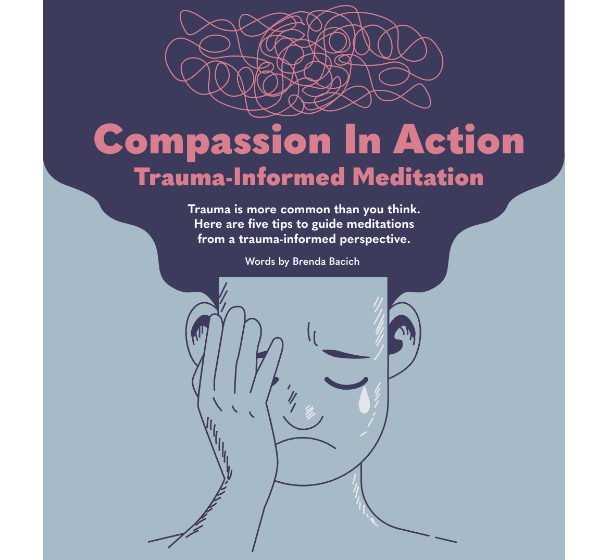Trauma is more common than you think.
The National Council for Mental Wellbeing estimates that 70% of US adults (more than 220 million people) have experienced at least one traumatic event in their lives.
~6% of US citizens are diagnosed with Posttraumatic Stress Disorder (PTSD) every year, while many more experience symptoms of trauma throughout their lives but don’t meet the criteria for a clinical diagnosis.
As a Licensed Professional Counselor specializing in trauma and grief & loss, I bear witness to, and hold space for, the pain, anger, helplessness, and fear that often permeate life after trauma.
As meditation teachers, we will inevitably work with trauma survivors in our classes and offerings – even if we don’t know who they are or what they’ve been through. We must be prepared to gently support our students, by being aware of the number of people who carry silent scars. We can do this through adopting a trauma-informed perspective.
5 Tips To Make Your Meditation Teaching Practice More Trauma-Informed
- Be aware of the prevalence of trauma.
Many meditation teachers think of trauma as a rare condition that they are unlikely to encounter often in their day-to-day teaching practice. Simply by being aware of the fact that the majority of the population has experienced at least one traumatic event, we can be more sensitive to the fact that we are likely working with trauma survivors in our classes, more often than we may have realized.
- Create a safe space.
In initiating a yoga or meditation class, I ask those journeying with me to create and hold a space of safety which will be held for ourselves and the others in the room throughout our time together.
I ask that within that space, we let go of competition or judgment of ourselves and others, and begin to allow ourselves to feel a sense of safety as we connect with the energy in the room.
I ask that we give ourselves permission to experience any thought, emotion or sensation that emerges from a space of non-judgmental observation, and with the knowledge that no state is permanent.
I ask for gentleness with self and others, thereby creating a space of safety and support.
- Use trauma-informed language.
Many of the traditional words and cues we use when guiding meditations can be “triggering” (or “activating”) to those who are living with trauma. In some cases, a word or phrase can take a trauma survivor into a memory of a traumatic event, and they may experience emotions that feel like the event is still occurring. This is often called a “flashback” and can result in the physiological response of fight, flight or freeze.
For example, the words “just relax” are used in many meditations, and would seem to most people to be perfectly harmless. But for many person who have experienced sexual trauma, these very words may have been used during the assault, and can trigger a flashback. We can substitute other words, like “soften” or “release” at times when we sense it may be helpful to do so.
Even the word “triggered” can be a “trigger” (or “trauma reminder”) for people who have experienced gun-related trauma. We can use words like “activated” instead.
- Shift from directive to inclusive/inviting language.
Often, in guiding our meditation sessions, we speak in a directive manner, leading our attendees to do and feel certain things. For example, we may say “close your eyes” or “focus on your breath.”
While this is offered in a gentle and well-intentioned manner, directive language can make a trauma survivor feel like she is being controlled, and reduce her sense of agency. Shifting to more invitational wording – like “I invite you to close your eyes, in your own time, if it feels comfortable to you” – can build trust, choice, transparency, and invite people into the space at their own pace.
- Evolving our practice while treating ourselves with patience and kindness
By recognizing that a vast majority of us have experienced some kind of trauma in our lives, we can show more empathy and kindness, and share understanding. This trauma-informed perspective can help us to move toward living a life of intentional compassion and loving-kindness.
At the same time, in being gentle with ourselves, we keep in mind that we, as human beings, will sometimes slip into past patterns. When we recognize that this is occurring, we can modify our language and focus, take responsibility for our actions and make micro-adjustments to our thinking – in the same way that we would gently shift if we noticed that we were not appropriately positioned in our Tree Pose in our yoga practice.
The evolution toward trauma-informed guidance is a journey in being gentle and compassionate, both with ourselves and with those we serve.
The Buddhist understanding of compassion is the wish for others to be free of suffering and causes of suffering. Guiding meditation from a trauma-informed perspective allows us to embody that compassion.
BLURB, BUBBLE, OR SIDEBAR: THE APA’S DEFINITION OF TRAUMA
The APA defines trauma as a “disturbing experience that results in significant fear, helplessness, dissociation, confusion, or other disruptive feelings intense enough to have a long-lasting negative effect on a person’s attitudes, behavior, and other aspects of functioning. Traumatic events include those caused by human behavior (e.g., rape, war, industrial accidents) as well as by nature (e.g., earthquakes) and often challenge an individual’s view of the world as a just, safe, and predictable place.”

To learn more about Trauma Informed Meditation Teaching, check out our Meditation Teacher Training (MTT-200)!









